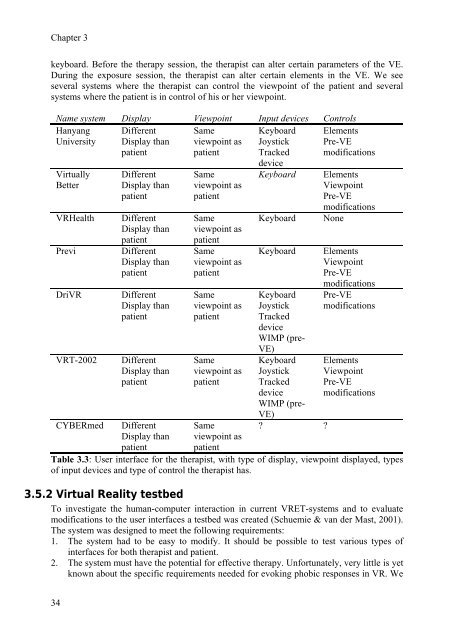Human-Computer Interaction and Presence in Virtual Reality
Human-Computer Interaction and Presence in Virtual Reality
Human-Computer Interaction and Presence in Virtual Reality
Create successful ePaper yourself
Turn your PDF publications into a flip-book with our unique Google optimized e-Paper software.
Chapter 3<br />
keyboard. Before the therapy session, the therapist can alter certa<strong>in</strong> parameters of the VE.<br />
Dur<strong>in</strong>g the exposure session, the therapist can alter certa<strong>in</strong> elements <strong>in</strong> the VE. We see<br />
several systems where the therapist can control the viewpo<strong>in</strong>t of the patient <strong>and</strong> several<br />
systems where the patient is <strong>in</strong> control of his or her viewpo<strong>in</strong>t.<br />
34<br />
Name system Display Viewpo<strong>in</strong>t Input devices Controls<br />
Hanyang<br />
University<br />
<strong>Virtual</strong>ly<br />
Better<br />
Different<br />
Display than<br />
patient<br />
Different<br />
Display than<br />
patient<br />
VRHealth Different<br />
Display than<br />
patient<br />
Previ Different<br />
Display than<br />
patient<br />
DriVR Different<br />
Display than<br />
patient<br />
VRT-2002 Different<br />
Display than<br />
patient<br />
CYBERmed Different<br />
Display than<br />
patient<br />
Same<br />
viewpo<strong>in</strong>t as<br />
patient<br />
Same<br />
viewpo<strong>in</strong>t as<br />
patient<br />
Same<br />
viewpo<strong>in</strong>t as<br />
patient<br />
Same<br />
viewpo<strong>in</strong>t as<br />
patient<br />
Same<br />
viewpo<strong>in</strong>t as<br />
patient<br />
Same<br />
viewpo<strong>in</strong>t as<br />
patient<br />
Same<br />
viewpo<strong>in</strong>t as<br />
patient<br />
Keyboard<br />
Joystick<br />
Tracked<br />
device<br />
Elements<br />
Pre-VE<br />
modifications<br />
Keyboard Elements<br />
Viewpo<strong>in</strong>t<br />
Pre-VE<br />
modifications<br />
Keyboard None<br />
Keyboard Elements<br />
Viewpo<strong>in</strong>t<br />
Pre-VE<br />
Keyboard<br />
Joystick<br />
Tracked<br />
device<br />
WIMP (pre-<br />
VE)<br />
Keyboard<br />
Joystick<br />
Tracked<br />
device<br />
WIMP (pre-<br />
VE)<br />
? ?<br />
modifications<br />
Pre-VE<br />
modifications<br />
Elements<br />
Viewpo<strong>in</strong>t<br />
Pre-VE<br />
modifications<br />
Table 3.3: User <strong>in</strong>terface for the therapist, with type of display, viewpo<strong>in</strong>t displayed, types<br />
of <strong>in</strong>put devices <strong>and</strong> type of control the therapist has.<br />
3.5.2 <strong>Virtual</strong> <strong>Reality</strong> testbed<br />
To <strong>in</strong>vestigate the human-computer <strong>in</strong>teraction <strong>in</strong> current VRET-systems <strong>and</strong> to evaluate<br />
modifications to the user <strong>in</strong>terfaces a testbed was created (Schuemie & van der Mast, 2001).<br />
The system was designed to meet the follow<strong>in</strong>g requirements:<br />
1. The system had to be easy to modify. It should be possible to test various types of<br />
<strong>in</strong>terfaces for both therapist <strong>and</strong> patient.<br />
2. The system must have the potential for effective therapy. Unfortunately, very little is yet<br />
known about the specific requirements needed for evok<strong>in</strong>g phobic responses <strong>in</strong> VR. We
















